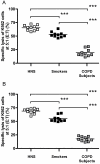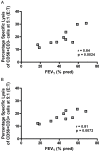Altered effector function of peripheral cytotoxic cells in COPD
- PMID: 19545425
- PMCID: PMC2705911
- DOI: 10.1186/1465-9921-10-53
Altered effector function of peripheral cytotoxic cells in COPD
Abstract
Background: There is mounting evidence that perforin and granzymes are important mediators in the lung destruction seen in COPD. We investigated the characteristics of the three main perforin and granzyme containing peripheral cells, namely CD8+ T lymphocytes, natural killer (NK; CD56+CD3-) cells and NKT-like (CD56+CD3+) cells.
Methods: Peripheral blood mononuclear cells (PBMCs) were isolated and cell numbers and intracellular granzyme B and perforin were analysed by flow cytometry. Immunomagnetically selected CD8+ T lymphocytes, NK (CD56+CD3-) and NKT-like (CD56+CD3+) cells were used in an LDH release assay to determine cytotoxicity and cytotoxic mechanisms were investigated by blocking perforin and granzyme B with relevant antibodies.
Results: The proportion of peripheral blood NKT-like (CD56+CD3+) cells in smokers with COPD (COPD subjects) was significantly lower (0.6%) than in healthy smokers (smokers) (2.8%, p < 0.001) and non-smoking healthy participants (HNS) (3.3%, p < 0.001). NK (CD56+CD3-) cells from COPD subjects were significantly less cytotoxic than in smokers (16.8% vs 51.9% specific lysis, p < 0.001) as were NKT-like (CD56+CD3+) cells (16.7% vs 52.4% specific lysis, p < 0.001). Both cell types had lower proportions expressing both perforin and granzyme B. Blocking the action of perforin and granzyme B reduced the cytotoxic activity of NK (CD56+CD3-) and NKT-like (CD56+CD3+) cells from smokers and HNS.
Conclusion: In this study, we show that the relative numbers of peripheral blood NK (CD56+CD3-) and NKT-like (CD56+CD3+) cells in COPD subjects are reduced and that their cytotoxic effector function is defective.
Figures






References
-
- Agusti A, Soriano JB. COPD as a Systemic Disease. COPD. 2008;5(2):133–138. - PubMed
Publication types
MeSH terms
Substances
LinkOut - more resources
Full Text Sources
Medical
Research Materials

